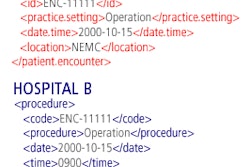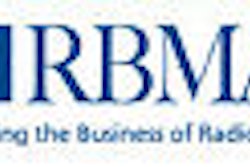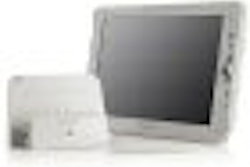Speech recognition technology can reduce report generation time from days to hours, especially when used in tandem with RIS/PACS, according to a pair of studies from Europe. Careful planning and integration with PACS are keys to a successful speech recognition implementation, according to researchers.
Researchers from the U.K. and Germany presented their experiences with speech recognition in a pair of presentations at the 2007 European Congress of Radiology (ECR) in Vienna in March.
In one study at Hammersmith Hospitals NHS Trust in London, speech recognition technology eliminated "significant delays" in report transcription and typing issues, leading to an improvement in service to both clinicians and patients. Researchers at Hammersmith Hospital and Charing Cross Hospital also concluded that a well-planned organization-wide implementation of speech recognition technology "can have a dramatic impact on radiology service delivery."
The two facilities are tertiary-referral teaching hospitals, which handle approximately 230,000 studies per year. Since 2003, the two hospitals have shared the same RIS/PACS. "However, this pathway from report generation to availability on PACS experienced a significant bottleneck at the type stage," noted Dr. Jonathan L. Hart in his presentation at ECR 2007.
The problem was remedied somewhat at Hammersmith Hospital when the report was available on tape, but the information remained inaccessible for Charing Cross Hospital until it was placed on the RIS/PACS network. That's one of the reasons why the facilities turned to speech recognition technology, which was fully integrated into the RIS/PACS in December 2004.
The Hammersmith study covered 26 months, from January 2004 to February 2006, reviewing speech recognition's impact on report generation time, its verification, and when the information became available on the RIS/PACS. All modalities were reviewed.
Improved turnaround
In 2004, emergency room and primary care reports took three to five days to complete at Hammersmith Hospital. Finished inpatient and outpatient reports ranged from a low of three days to as many as eight days for inpatient reports in August 2004. With the advent of speech recognition technology, the time from report generation to completion declined to one to two days from January 2005 to February 2006.
Charing Cross had a similar experience. Emergency room and primary care reports took five to seven days to complete in 2004. When speech recognition was integrated into the RIS/PACS, the time was reduced to one to three days. Inpatient and outpatient reports, which took seven to 11 days to complete in 2004, were down to two to four days in 2005 and the first two months of 2006 (with the exception of May 2005, when inpatient reports topped at almost seven days).
The study found "a statistically significant and sustained fall in time from production to verify a report, and a majority of the studies are (completed) the same day," Hart noted, adding that the outcomes were achieved despite an increase in the volume and complexity of the imaging studies. "The reality today is that the majority of studies take a matter of hours and, on some occasions, (are completed) before the patients return to the wards."
PACS integration
One key to successful implementation of the speech recognition technology, Hart said, was the "full integration with the PACS on the desktop. We access it from within the PACS and we are not using any additional workstations."
The two hospitals also laid the foundation for the project with what Hart described as "extensive planning," followed by a period of testing the technology and its integration on standard PCs and the PACS with dummy studies. "We had in-house training for a week prior to the transition date and some good onsite consultation specialists and support during the first week of transition," and the project was completed without major problems, he added.
Hart said another key consideration in implementation is the interface compatibility between the speech recognition system and the PACS, if they are from different vendors. In addition, an upgrade to one system "can have implications for the smooth running of the other," he cautioned.
RIS/PACS connection
The second study presented at ECR originated at the department of clinical radiology at Ludwig-Maximilians-University in Munich, Germany. The facility handles approximately 120,000 exams per year, with 24 residents and four full-time and three part-time transcriptionists.
The RIS/PACS from Siemens Medical Solutions of Erlangen, Germany, was integrated in July 2003, while the speech recognition technology at the hospital is SpeechMagic 5.1 from Philips Speech Recognition Systems of Vienna. Offline, the speech recognition technology is server-based for transcription correction, while the online technology allows for radiologist correction and final sign-off.
The study consisted of a RIS/PACS analysis to calculate turnaround time between the entry of the last image in a study to the availability of a RIS report, as well as cumulative report availability or the presentation of the report.
Co-author Dr. Christoph Trumm noted that the study reviewed two six-month periods. The first segment -- from January to June 2003 -- reviewed standard transcription only, while the second phase -- from January to June 2005 -- offline and online speech recognition was analyzed for conventional radiography, CT, and MR exams. Mammography was excluded.
Speech recognition technology again helped reduce report turnaround time significantly. "We had a rapid improvement from 24 to 3.5 hours during routine working hours, and on weekend shifts to less than one hour," Trumm said.
In addition, online speech recognition and radiologist self-editing correction also "has facilitated the increasing ratio of digital availability of conventional radiography reports at any time, while CT exams during weekend shifts have better turnaround times."
By Wayne Forrest
AuntMinnie.com staff writer
May 4, 2007
Related Readings
RIS-SR-PACS combo speeds radiology reporting, April 17, 2007
Speech recognition technology shows double-digit error rate, November 30, 2006
HIT needs, cost factors drive speech recognition implementation, September 27, 2006
Meeting the challenge of structured reporting, June 23, 2006
Voice recognition speeds operations, irks radiologists, May 17, 2006
Copyright © 2007 AuntMinnie.com



















